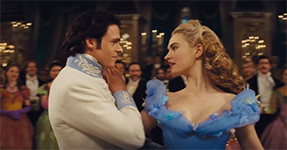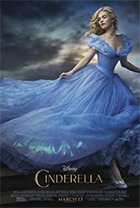Cinderella (2015)
|  The first of what will certainly turn out to be many live-action adaptations of classic Disney animated films, Cinderella is really a quite marvelous endeavor that not only improves substantially on the relatively leaden and dated 1950 animated version in ways both subtle and direct, but stands on its own as a genuinely moving romantic ode to kindness, decency, and the intensity of real romantic attraction. Directed by Kenneth Branagh, who started his career 30 years ago as a particularly vivid cinematic adapter of William Shakespeare, but most recently directed Marvel’s Thor (2011) and the Tom Clancy prequel Jack Ryan: Shadow Recruit (2014), Cinderella is both deeply sensual and utterly innocent, a rare combination that makes the film stand out amid the cultural cynicism and moral dissolution that allows something like Fifty Shades of Grey to pass for romance. It is hopelessly old-fashioned, but in all the best ways. The first of what will certainly turn out to be many live-action adaptations of classic Disney animated films, Cinderella is really a quite marvelous endeavor that not only improves substantially on the relatively leaden and dated 1950 animated version in ways both subtle and direct, but stands on its own as a genuinely moving romantic ode to kindness, decency, and the intensity of real romantic attraction. Directed by Kenneth Branagh, who started his career 30 years ago as a particularly vivid cinematic adapter of William Shakespeare, but most recently directed Marvel’s Thor (2011) and the Tom Clancy prequel Jack Ryan: Shadow Recruit (2014), Cinderella is both deeply sensual and utterly innocent, a rare combination that makes the film stand out amid the cultural cynicism and moral dissolution that allows something like Fifty Shades of Grey to pass for romance. It is hopelessly old-fashioned, but in all the best ways.The screenplay by Chris Weitz (About a Boy, The Golden Compass) follows the general beats of Disney’s animated version, although it fills in some of the narrative gaps and fleshes out its weaker characters, particularly the Prince, who has previously been little more than a wealthy and handsome cipher, but is here recreated as a fully realized character with his own desires and moral compass. Notable, too, is the heavier presence of Cinderella’s parents (Ben Chaplin and Hayley Atwell), who instill in their young daughter a sense of moral fortitude that feels like a genuine strength of character, rather than lazy shorthand for some simplistic notion of inherent goodness. “Have courage and be kind,” Cinderella’s mother tells her, a mantra by which she attempts to live even after both of her parents have died, leaving her to live as little more than a servant to her cruel, avaricious stepmother, Lady Tremaine (Cate Blanchett), and her stepsisters, Drisella (Sophie McShera) and Anastasia (Holliday Grainger). While Cinderella’s predicament in the animated version never carried much weight (the malice of her stepfamily was too cartoonish, and Cinderella herself was too much of a one-note optimist), the cruelty inflicted on her in Branagh and Weitz’s film has real bite. We feel Cinderella’s pain, partially because we recognize that it constantly challenges what her parents have instilled in her, thus threatening to crush the memories she holds dear. Everything changes when Cinderella (Lily James) meets the Prince (Richard Madden) in the woods one day and they have a flirtatious exchange in which they both hide aspects of their identity from the other without actually lying (she never tells him her name and he disguises the fact that he is royalty by referring to himself as an apprentice). They are both clearly smitten with each other, and the manner in which this attraction is conveyed becomes one of the film’s primary strengths: Branagh’s direction, with its emphasis on close-ups and attention to the smallest gestures and flickers of the eye, and the beautiful performances by James and Madden make the idea of love at first sight, which in lesser hands would feel like a stodgy narrative contrivance, both convincing and utterly palpable. Cinderella and the Prince have real chemistry together, and the heat between them only grows as the film progresses, especially once they see each other again at the ball, which the King (Derek Jacobi) holds to find a suitable princess for his son to marry. The fact that there are so many obstacles standing between them—not just the wicked stepmother, but also Stellan Skarsgård’s scheming Duke and, to some extent, the King himself, who believes in marriage for advancement, not love—only makes their obvious emotional connection and physical attraction all the more euphoric. What Branagh brings to the film that was so utterly lacking in the animated version is a sense of what can only be described as eroticism, although that is not to suggest that the story has been crassly sexualized in a way that detracts from its sense of wonder and innocence (this is a film, after all, in which there is only one kiss, and it happens at the very end). Branagh shapes many of the film’s most indelible moments with a sensuality that heightens the romanticism. Note, for example, the electric response of both Cinderella and the Prince when he first puts his hand on her waist at the ball. And when Cinderella’s torn dress is magically transformed into a gorgeous, flowing gown, Branagh stages it and Lily James plays it as though the transformation itself is a rapturous, sensual pleasure. And later at the ball, when one of Cinderella’s glass slippers falls off and the Prince puts it back on for her, they both look positively post-coital. It should come as no surprise, then, that this moment takes place in a secret garden that, as Ariel Fisher helpfully points out in her essay “On ‘Cinderella’ and Feminism; How Branagh and Weitz Altered the Glass Slipper,” essentially recreates Jean-Honoré Fragonard’s 1767 painting “The Happy Accidents of the Swing,” which was considered scandalous at the time for suggesting both adolescent sexuality and some degree of female sexual autonomy. In short, Branagh takes the all-too-familiar beats of the story and plumbs them for deeper levels of feeling and physicality, merging the sensual and the chaste in a way that is uniquely compelling in its experiential bliss. He and Weitz don’t rework the story substantially; there is no overly revisionist attempt to make Cinderella into a feminist heroine by having her take up a sword ala Alice in Disney’s Alice in Wonderland (2010), nor should there be. Simply by giving Cinderella a deeper sense of character and allowing her to play an active role in her romantic involvement, they undercut the inherent sexism of the original story while maintaining the fairy tale delight. And, while Branagh takes the material seriously, he also plays a number of scenes for laughs, something he did with surprising dexterity in Thor (some of the pratfalls feel a bit over the top, but most of the humor works with great effectiveness). He also allows for some wonderfully weird touches, such as making the Fairy Godmother (Helena Bonham Carter) turn a pair of lizards into Cinderella’s coachmen and a goose into her driver without their losing some of their animal characteristics. Branagh is aided substantially by an impressive cast and crew drawn primarily from European film and television. The music by Patrick Doyle, whose collaboration with Branagh goes back to their mutual feature film debut Henry V (1989), is elegant and substantive without being intrusive, and the cinematography by Haris Zambarloukos, who previously shot Sleuth (2007) and Thor for Branagh, is appropriately sumptuous, but without losing some of the primal earthiness that keeps the fairy tale grounded. Special note should also be made of the production design by veteran Dante Ferretti, who, over his lengthy career, has worked with the likes of Pier Paolo Pasolini, Federico Fellini, Neil Jordan, Julie Taymor, Tim Burton, and Martin Scorsese. His work here treads a delicate balance between staying true to the audience’s memory of the animated version while also building on and expanding it, such as turning the coach into an ornate golden vessel and Cinderella’s childhood home into a fantasy of pastoral bliss. The film’s leads, Lily James and Richard Madden, are relatively unknown on the Hollywood big screen, as they both hail primarily from television—Downtown Abbey and Game of Thrones, respectively—while the rest of the cast is filled with familiar faces, including Helena Bonham Carter as the Fairy Godmother, who first appears as an old crone but then metamorphoses into a more conventionally maternal, albeit slightly ditzy figure; Shakespeare vet Derek Jacobi as the dying king; and Stellan Skarsgård as the conniving Duke. Cate Blanchett has one of the meatiest roles as Lady Tremaine, aka “The Wicked Stepmother,” and as we would expect from an actress of her caliber, she brings a wealth of depth to what could be a one-note villain, playing Tremaine’s most vile actions with hints of insecurity and desperation that make her spiteful character as pathetic as she is abhorrent, which also helps Cinderella’s eventual forgiveness of her feel more genuine (she reminded me quite a bit of Billy Zane’s much maligned and misunderstood Cal Hockley in James Cameron’s Titanic, another scheming, anti-romantic villain whose worst instincts are the embodiment of his broken spirit). In adding nuance and depth to what is essentially a simplistic paean to the power of goodness and the outdated idea that all a girl needs is a dashing prince to save her, this new version of Cinderella breathes life into the familiar and, against the odds, makes the old seem new. Copyright ©2015 James Kendrick Thoughts? E-mail James Kendrick All images copyright © Walt Disney Studios |
Overall Rating: 


 (3.5)
(3.5)


